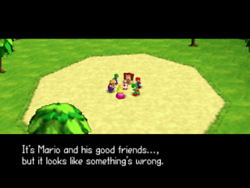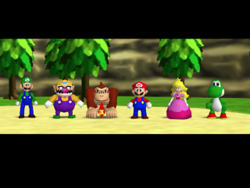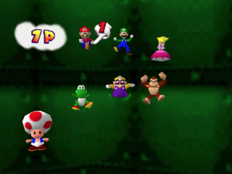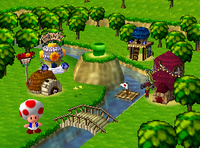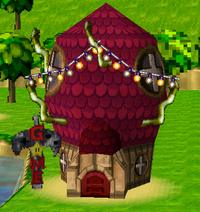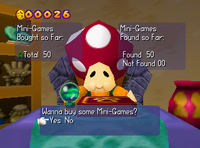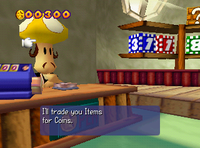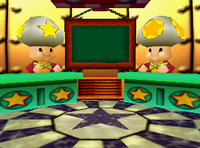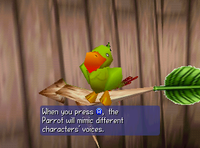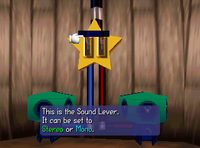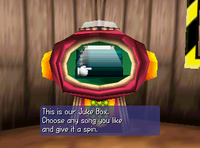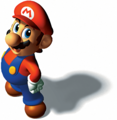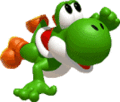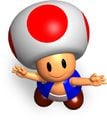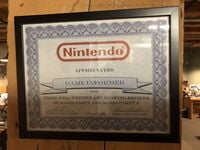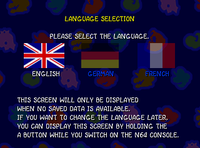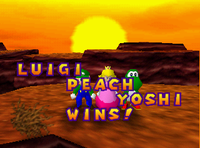Mario Party: Difference between revisions
mNo edit summary |
m (Original source was jpg) |
||
| Line 2: | Line 2: | ||
{{about|the first ''Mario Party'' game for the [[Nintendo 64]]|the series as a whole|[[Mario Party (series)]]}} | {{about|the first ''Mario Party'' game for the [[Nintendo 64]]|the series as a whole|[[Mario Party (series)]]}} | ||
{{game infobox | {{game infobox | ||
|image=[[File:MP1 Cover. | |image=[[File:MP1 Cover.jpg|250px]] | ||
|developer=[[Hudson Soft]]<br>[[CAProduction]] | |developer=[[Hudson Soft]]<br>[[CAProduction]] | ||
|publisher=[[Nintendo]] | |publisher=[[Nintendo]] | ||
Revision as of 07:07, May 27, 2023
- This article is about the first Mario Party game for the Nintendo 64. For the series as a whole, see Mario Party (series).
| Mario Party | |||||
|---|---|---|---|---|---|
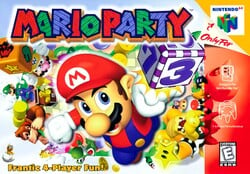 For alternate box art, see the game's gallery. | |||||
| Developer | Hudson Soft CAProduction | ||||
| Publisher | Nintendo | ||||
| Platform(s) | Nintendo 64 Nintendo 64 - Nintendo Switch Online | ||||
| Release date | Nintendo 64: Template:Release Nintendo 64 - Nintendo Switch Online: Template:Release[?] | ||||
| Language(s) | English (United States) French (France) German Japanese | ||||
| Genre | Party | ||||
| Rating(s) |
| ||||
| Mode(s) | Single-player, multiplayer | ||||
| Input | Nintendo 64: Nintendo Switch:
| ||||
Mario Party is a party game released for the Nintendo 64 as the first installment in the titular Mario Party series. Players select one of six Mario characters and move around the board, collecting coins and various other items to help themselves or hinder others in their quest to collect Stars. Players participate in mini-games after each turn, in which they compete for extra coins. These mini-games vary widely, from free-for-alls to pairs to three-on-ones. They test players' reflexes, puzzle-solving skills, and even luck. Certain mini-games allow players to steal coins from each other, while others grant the winner five coins from their rivals. Dueling mini-games in later installments would serve a similar purpose. This game is known for pioneering an iconic and renowned sub-series of the Mario franchise, which continues to this day, becoming one of the most well-known series in gaming.
While Mario Party was never re-released on any Virtual Console, it saw its first re-release on the Nintendo 64 - Nintendo Switch Online service on November 2, 2022, releasing alongside Mario Party 2.
Story
The story begins with Mario and his friends sitting around and arguing over who is the Super Star, the superior one among them. Wario claims that a Super Star must be strong. Donkey Kong agrees, while bragging about his strength. An argument and fight ensue between the two, with Luigi finding himself quite literally stuck in the middle. It is also suggested that Mario would make a good superstar, or Princess Peach, or even the energetic Yoshi.
The gang begins to close in on Toad, who jumps and shouts out that he has an idea of what they should do. Arguing that being a Super Star takes not only strength, but also courage, wisdom, and kindness, he suggests that the crew take the Warp Pipe in Mushroom Village, and find out who is the Super Star of their adventures. Though he warns them that the path will be dangerous, all six of the competitors race toward the pipe and enter it one by one, thus beginning the game itself.
Characters
Playable
The game features a total of six playable characters - Mario, Luigi, Princess Peach, Yoshi, Wario, and Donkey Kong. Due to the format of this game, each character controls and plays the same regardless of personality. Notably, Wario is referred to as one of Mario's friends, making his first appearance as an ally of Mario's rather than an enemy.
| white | white | white | white | white | white | ||||||
|---|---|---|---|---|---|---|---|---|---|---|---|
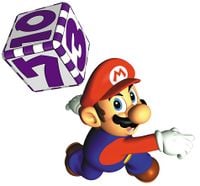
|
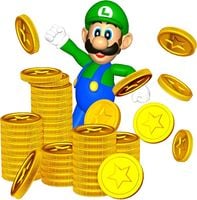
|
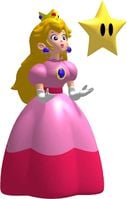
|
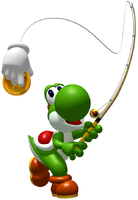
|
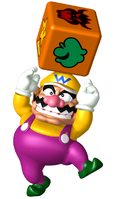
|
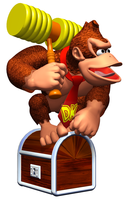
|
Game modes
Game modes are selected from a "Map" screen, Mushroom Village, that the player is led to upon starting the game. Each building or feature represents a mode, and the player can select one to play a certain mode.
Listed below are the available areas for the player to access in Mario Party:
Party mode
Party mode is the heart of Mario Party. Four players will play on a board game, each getting a turn to roll the 1-10 Dice Blocks, which will determine how many spaces they will move across. After everyone rolls, a roulette will appear which will randomly select a minigame to play. This process will repeat itself until the set amount of turns is up.
Boards
| Board | Description | Difficulty | |
|---|---|---|---|

|

|
DK's Jungle Adventure is Donkey Kong's board. Players aim to collect Stars to locate the mysterious treasure that is locked away in the jungle's ancient ruins. Four Whomps are guarding the junctions; to pass, a player must pay 10 Coins. Landing on a Happening Space triggers a rolling boulder which in turn chases down any players standing in its way to the path near the start of the board. If a player happens to meet Bowser on this board, they are "awarded" a useless Golden Bowser Statue and are forced to pay him 10 coins. | |
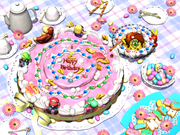
|

|
Peach's Birthday Cake is Princess Peach's board. It is the smallest map of the ones available in Mario Party. Its main feature is the Flower Lottery, hosted by Goomba, where a player plants a red, blue, yellow, or green seed (at the cost of 10 coins) and grows a flower. Three flowers have a Toad face, while one flower has a Bowser face on it. After all four seeds are planted, four new ones can be chosen. This is run by a Goomba, who says if a player gets the Bowser face, they will go to Bowser, who will sell him the Bowser Cake, one of Bowser's bogus items, for 20 coins. If a player gets a Toad face, they will go in the direction of the Star. If a player lands on a Happening Space, they have the opportunity to plant a "Strawberry Seed" at the cost of 30 coins, which grows into a Piranha Plant. Once planted, if another player with stars lands on the Happening Space with the Piranha Plant there, it will steal a Star from that player, and give it to the player that planted it. | |
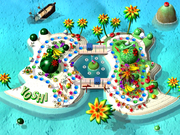
|

|
Yoshi's Tropical Island is Yoshi's board. Consisting of Watermelon Island, Cantalope Island, and a small island in the middle, it was said that many Yoshis live here, but only two are shown in the middle of the board. A Pink Yoshi is on the small island and is surrounded by whirlpools, with a Blue Yoshi who cannot do anything about it. Players aim to collect stars to get rid of the whirlpools and reunite the two Yoshis. The Happening Spaces make Bubba the fish take Toad to the opposite island, Bowser taking his place. Bowser sells defective Bowser Tubes to players for 30 coins. Two Thwomps block both ways to the opposite island, and request fees from players if they want to pass. The fee always starts at one coin, but goes up by one coin each time until it reaches the limit of 50 coins to pass. | |
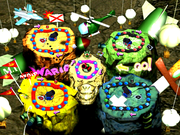
|

|
Wario's Battle Canyon is Wario's board. It is set on a canyon that has been split into four areas with Bowser's area in the middle. Players aim to collect stars to stop the feud between the Bob-omb Buddies and the Bob-ombs. To get around the board, players are placed into cannons and fired to another area; the area they are sent to is determined by a spinning wheel. If a player lands on a Happening Space, the Bob-ombs will switch the directions of the cannons. Bowser's area can only be reached by asking the Fly Guy in the northeast area to carry the character conversing with him to Bowser for ten coins. Bowser also has a cannon in this area to replace his bogus item. However, instead of firing at a specific part of the board, Bowser will just fire a character at a random spot. | |

|

|
Luigi's Engine Room is Luigi's board. Players need to collect stars to power up the engine in the middle of the room (but actually in the back of the playing board). The main feature is the board-wide system of red and blue doors. One set rises up to block specific paths while the other set goes down to open other paths. The doors switch at the start of every turn, when players land on certain Happening Spaces, or if a robot on the board is paid 20 coins to switch them. ? spaces on steam generators near the engine make steam rise out of the respective generator, propelling players to a higher section. Players that go to Bowser will see his "Make As Many Coins As You Want Mecha" in action. They will get a coin from Bowser, at the cost of 20 coins. No matter where the players go, all paths end in Warp Pipes that lead to Boo, who is near the start. | |
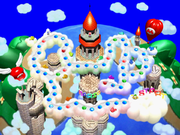
|

|
Mario's Rainbow Castle is Mario's board. It is placed on clouds with multiple towers and is sky-themed. The main feature of this board is that the location of the Star does not change each time a player receives one. Instead, it is always located on the main tower of the map. Each time a player does receive a Star, however, the tower rotates, revealing Bowser. When the player reaches the tower while Bowser is there, he charges 40 coins for a Ztar. Unlike their later appearances, they do not affect the star count, merely serving to waste the 40 coins. The tower can also be rotated by any player landing on a Happening Space. | |
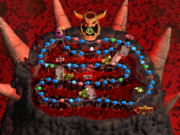
|

|
Bowser's Magma Mountain is Bowser's board, taking place on the summit of a gigantic volcano. The main feature of the board involves various stone heads that offer shortcuts throughout the board for 10 coins. If the player accepts, a roulette block will appear containing either Bowser's face or a Star. If the latter is hit, the player is allowed to take the shortcut. However, if they choose Bowser's face, the player is forced to continue on their original path. Eventually, the player will reach a purple-colored Stone Head, who will offer the same roulette block, except free of charge. This time, however, if the player selects Bowser's Face, they will automatically follow a path directly to Bowser, who will steal 20 coins or a Star (depending on the roulette) from the player. This board is only available if bought for 980 coins and after all other boards are played at least once. If the player lands on a Happening Space, Bowser's volcano will erupt, turning all Blue Spaces into Red Spaces. | |
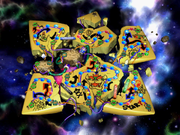
|

|
Eternal Star is the final board of Mario Party. It is unlocked by collecting 100 Stars and completing all the boards at least once. On this space-themed board, Koopa Troopa is kidnapped at the very beginning of the game by Bowser, and players move around the star using warp stations and must retrieve Stars from seven Baby Bowsers. Upon reaching a Baby Bowser, players must pay their 20 coins and roll higher than him to get a Star. The player's Dice Block can roll 8-10 but Baby Bowser's can roll any number. If the player wins, they get a Star, but if they lose, they lose a Star. In the center of the star is Bowser; upon reaching him, he takes a Star from the player who reached him (or 20 coins if they do not have any Stars) and sends them back to the start and changes the routes of the Warp Machines. If a player lands on any Happening Space, Bowser will send everyone back to start, though the Warp Machine routes remain unchanged. | |
Spaces
| Space | Description | |
|---|---|---|
| Blue Space | Players gain three coins from landing on this. The amount of coins received is doubled in the last five turns. This space is the most common space on all boards. | |
| Red Space | Anybody who lands on this space loses three coins. On the last five turns, this amount will be doubled. | |
| Happening Space | A variety of events happen if anyone happens to land on this space. These events can help or harm one or more players, and they differ from board to board. | |
| Chance Space | A player that lands here plays a Chance Time game. The player hits three blocks, which identify two players and what one gives to the other. Game-changing events can happen here, from trading stars or coins, to giving one star or 10-30 coins to someone else. | |
| Mini-Game Space | A player that lands here plays a One-Player Mini-Game. If the player wins the mini-game, they receive coins. If they lose, then the player loses five coins. If the game is a bonus mini-game though, the player is rewarded the amount of coins collected, but not lose any if they get none. | |
| Mushroom Space | A roulette block appears if a player lands on this space. Either the player can receive a Mushroom, which gives the Player the chance to roll another dice block, or receive a Poison Mushroom, which forces them to forfeit their next turn's Dice Block roll. | |
| Bowser Space | Any player who lands on this space triggers a roulette, which any of these events can follow:
If the player who lands on this space has at least one Star but no coins, Bowser gives the player 10 coins in exchange for their Star. However, if they do not have any Stars or coins, Bowser will always give them 20 coins regardless of what place they are in. | |
| Star Space | When a player passes here, they can obtain a Star only if they have at least 20 Coins. The Star Space does not count towards the player's movements, unlike other spaces. On most boards, the player can purchase a Star for 20 coins from Toad, and they can also decline. However, on Eternal Star, the player needs to defeat 1 out of 7 Baby Bowsers to get it. If they win, Baby Bowser will give up a Star, leaving a Chance Space behind. However, if the player loses, Baby Bowser will take a Star away from the player. |
Mushroom Village
Mini-Game House
The Mini-Game House is located to the right side of the river, and resembles a mushroom with a large, red cap.
Free Play
The Free Play wall allows the player to access all mini-games they have unlocked so far and can play them as many times as they like for free.
Toad
The resident Toad of the Mini-Game house is an elderly-looking one named Puff who has a large red cap on her head, similarly shaped to the Mini-Game House itself. By speaking to her, the player is given a list of mini-games that have been played in the game so far. There are various price ranges for mini-games. Once one is bought, it can always be played for free via the orb on the table.
Pot o' Skills
The Pot o' Skills leads to the Mini-Game Stadium. The Mini-Game Stadium has its own board shaped in the form of a star, and only has 24 total spaces. Each turn, players roll the dice and advance the number of spaces, like in Party Mode. However, blue spaces do not add coins and red spaces do not subtract coins. All coins are gained or lost from mini-games which are played at the end of each turn. There is a One-Player mini-game space as well. Passing Koopa will result in 10 coins for the player. At the end of the game, the player with the most coins wins.
Mushroom Shop
The Mushroom Shop is run by the Mushroom Shop Clerk and is located on the left side of the river on the map; it resembles a brown mushroom on its side. In the shop, various items can be bought with Coins earned from mini-games and Party games. Here is a listing of every item, along with its price and in-game description.
| Image | Name | Price | In-Game Description | Notes |
|---|---|---|---|---|
 |
This appears randomly, and you get the number of coins shown. | |||
 |
This appears randomly, and you lose the number of coins shown. | |||
 |
This appears randomly, and only numbers eight to 10 will appear on the block. | |||
 |
This appears randomly, and only numbers one to three appear on the block. | |||
 |
This appears randomly, and players change positions on the board. | |||
 |
This appears randomly, and Boo, Koopa Troopa or Bowser will appear. | |||
 |
This counts how many times you rotate the Control Stick. Use it in the Mini-Game House. | |||
 |
This is the Record for the Juke Box in the Option House. | |||
 |
This Parrot is good at mimicking characters' voices. It lives in the Option House. | |||
 |
Get 10 percent interest on Coins you collect with this Lucky Box. | |||
 |
Bet your Coins with this Box to get double or half of what you actually collected. | |||
 |
This will let you go to the hidden board map of Magma Mountain. | |||
 |
This lets you see the End Credits and the names of people who made the game. | Complete the Eternal Star map to obtain this. | ||
| Koopa Troopa won't appear on the map, but it won't work on some maps. | Complete the Eternal Star map to obtain this. | |||
| Boo won't appear on the map, but it won't work on some maps. | Complete the Eternal Star map to obtain this. | |||
 |
This has many Gameballs with Mini-Games inside. What you get is a surprise. | This item appears after at least 30 mini-games have been bought from the Mini-Game House and can be used until all mini-games are bought. |
Mushroom Bank
The Mushroom Bank is where players can store their coins as well as Stars and items. The bank is run by two portly Toads who are similar in every way except that one has yellow stars on his head in place of the usual dots, while the other has orange stars within yellow circles.
Porto
Porto[1] sits behind the left counter and is in charge of storing the items the player buys at the Mushroom Shop until they are used during a game. Here is also where the player can choose how they want to save their coins, whether with the Coin Box, Lucky Box, or Casino Box.
Bello
Bello sits behind the right counter and keeps track of the total coins and stars the player has saved up. He also keeps track of how many more stars need to be collected, out of 100, to unlock the Eternal Star map.
Option House
The Option House is a mushroom-resembling blue-topped toward the top of the map across the river. As the name suggests, it is used to adjust the multiple options for the game. There are other features such as the Talking Parrot and Juke Box as well.
Toad
The resident Toad of the Option House, whose name is Fun Gus,[2] can delete all saved data. Once spoken to and asked to delete all data, he takes out a remote and opens an electrical box on the other side of the house. The cover will open revealing a large red switch, and the player is asked if they are sure about deleting their data. Once the player accepts deleting the data, they should either press ![]() to press the switch and erase all data, or press
to press the switch and erase all data, or press ![]() to cancel the process.
to cancel the process.
Talking Parrot
The Talking Parrot is an item that can be bought from the Mushroom Shop, and once bought, will appear on a perch in the Option House. By pressing the ![]() button, the parrot speaks various voices from various characters in the game randomly. Two lines of dialogue were edited from the Japanese version to remove religious references, which were Luigi and Wario exclaiming "Oh my God!" after suffering misfortune. These voices include:
button, the parrot speaks various voices from various characters in the game randomly. Two lines of dialogue were edited from the Japanese version to remove religious references, which were Luigi and Wario exclaiming "Oh my God!" after suffering misfortune. These voices include:
- Boo
- Bowser
- Donkey Kong
- Koopa Troopa
- Luigi
- Mario
- Princess Peach
- Toad
- Yoshi
- Wario
- The "narrator" voice that announces events in mini-games such as "Time Up!", "Game Over!", "Draw!", etc.
Sound Lever
The Sound Lever is a lever that changes the sound from Mono to Stereo or vice versa. There are two speakers at the bottom with pipes leading up the lever. By pulling the lever down, one of the speakers is deactivated and the sound is changed to Mono. There is no surround sound.
Juke Box
The Juke Box allows the player to listen to any song from the game. The only prerequisite is that the player must have heard the song in the game itself before it becomes available on the Juke Box. The Juke Box becomes available for use after the player buys the Record from the Mushroom Shop for 50 Coins. For PAL and Japanese players, an extra song is available entitled "Move to the Mambo!", which is unavailable in the American version. No official explanation has ever been released as to why it was removed.
Mini-Game Island
Mini-Game Island is a special challenge in which the goal is to travel all around the island and beat every mini-game one by one. After beating every mini-game and reaching the end, Toad will challenge the player once more to a race against him and two other CPUs in Slot Car Derby. This mode is for one player only. Completing the mode will reward the player with the Bumper Ball Maze minigame, which can be accessed in the Minigame House.
Mini-games
- Main article: List of Mario Party minigames
Staff
- Main article: List of Mario Party staff
Pre-release and unused content
- Main article: List of Mario Party pre-release and unused content
Gallery
- For this subject's image gallery, see Gallery:Mario Party.
Media
- For a complete list of media for this subject, see List of Mario Party media. For this subject's sound test, see Mario Party sound test.
| File info 0:30 |
| File info 0:30 |
| File info 0:30 |
| File info 0:30 |
Reception and legacy
Mario Party received mostly positive reviews from critics. The most frequent criticism Mario Party received was the slow pacing and lack of enjoyment without multiplayer. GameSpot explains "The games that are enjoyable to play in multiplayer are nowhere near as good in single-player mode. Really it's that multiplayer competitive spark of screaming at and/or cheering for your friends that injects life into those often-simple little games and without it, they're just simple little games." IGN took a similar line, saying that it was the interaction between players rather than the interaction between the game that made Mario Party fun. Another common criticism was the game's dependence on luck rather than skill, though this was seen by many to add to the game's board game atmosphere, as players who were comfortably in the lead one turn could be losing the next.
In contrast, gaming magazine Game Informer viewed the game with much contempt.[3] All three reviewers note that the minigames are boring and those playing will not derive much enjoyment. Out of the three reviewers, Paul Anderson was the most charitable and gave the game an overall score of 5.5/10. However, he says the game is worthless and only serves to fill the first quarter of the year. Nintendo of America sent the magazine a sarcastic certificate over the publication's negative review of Mario Party and its sequel.[4] From then on, Game Informer became infamous for their constantly negative reviews of the Mario Party games, which usually get a positive reception from critics such as IGN and GameSpot, and their picky reputation has stuck since.
| Reviews | |||
|---|---|---|---|
| Release | Reviewer, Publication | Score | Comment |
| N64 | Andrew Reiner, Game Informer | 2.25/10 | "I stepped up to this review as a video game veteran, ready for anything. I've played every single N64 title out there, and have seen many sights and sounds. But even with this experience behind me, I wasn't prepared for what lurked within this N64 release. No game has assaulted me with this kind of ferocity, and no game has taken as many jabs below my belt as Mario Party. It seriously hurts to play this title. And no, it's not designed specifically for children. Even the kiddies will find Mario Party and its plethora of mini-games to be extremely boring and more of a chore than anything else. Heck, if I was a kid again, I'd run from this game like I would a spanking. As a matter of fact, I'd probably bite my lip and take the spanking rather than play this god-awful game again." |
| N64 | Peer Schneider, IGN | 7.9/10 | "Mario Party is an excellent party game for four people and we suggest everyone out there with three friends should own it (unless your three friends own it). But be prepared to spend at least an hour for a game and do a lot of waiting for the other players. Had the overall speed of gameplay been faster (especially when playing against computer players), Mario Party would have scored higher in our final review score. Still, this is probably one of the best "virtual board games" I have ever played and the inclusion of the many mini-games makes this one of the few ones that couldn't have been done better outside of a game console." |
| N64 | Joe Fielder, GameSpot | 7.2/10 | "Mario Party is intended to be played with a group of friends, and for those people who can really take advantage of that, this game is a must-buy. The less-social gamer might want to rent." |
| Aggregators | |||
| Compiler | Platform / Score | ||
| Metacritic | 79 | ||
| GameRankings | 78.02% | ||
Sales
Mario Party is the 17th best-selling game for the Nintendo 64, selling approximately 2.7 million copies: 1.23 million copies in North America, 870,000 copies in Japan, and 580,000 copies elsewhere.[citation needed]
Legal issues
Nintendo gave away a free Mario Party glove for a time after the game's release, the reason being that many players got blisters and other ailments on the palms of their hands due to the mini-games that involve spinning the ![]() around as fast as possible, which are Tug o' War, Paddle Battle, and Pedal Power (this was likely why Mario Party was not released on the Virtual Console, but Mario Party 2 was). Nintendo suggested that the players should use the thumb to spin the Control Stick, but this method is a lot slower than rotating with the palm, and the thumb can slip off the joystick. Receiving the glove required proof of purchase of the first game of the series. The glove giveaway did not surface until after the release of Mario Party 2. This was because Nintendo lost a class-action lawsuit that was filed by several families of the injured players and had to pay several thousands of dollars in damage reparations as a result. As a consequence of unbalanced difficulty and self-injury, as well as the Control Stick's high potential for decalibration through this method, there were no more mini-games after Mario Party that involved spinning the Stick as fast as possible until Mario Party: Island Tour was released since the analog stick on the 3DS made it safe to spin quickly without injuries.
around as fast as possible, which are Tug o' War, Paddle Battle, and Pedal Power (this was likely why Mario Party was not released on the Virtual Console, but Mario Party 2 was). Nintendo suggested that the players should use the thumb to spin the Control Stick, but this method is a lot slower than rotating with the palm, and the thumb can slip off the joystick. Receiving the glove required proof of purchase of the first game of the series. The glove giveaway did not surface until after the release of Mario Party 2. This was because Nintendo lost a class-action lawsuit that was filed by several families of the injured players and had to pay several thousands of dollars in damage reparations as a result. As a consequence of unbalanced difficulty and self-injury, as well as the Control Stick's high potential for decalibration through this method, there were no more mini-games after Mario Party that involved spinning the Stick as fast as possible until Mario Party: Island Tour was released since the analog stick on the 3DS made it safe to spin quickly without injuries.
In Mario Party Superstars, there is also a warning in place for the Tug o' War and Cast Aways minigames for players not to use their palms while playing the minigame, referencing the issue. A similar warning appears for the Nintendo Switch Online version of Mario Party when starting the game.
Regional differences
Differences exclusive to the Japanese version
In the Japanese version, Wario and Luigi say "Oh my God!" when they lose or otherwise suffer misfortune. This was changed in the Western versions to remove religious references; Luigi wails in pain instead, and Wario says "So ein Mist!" (the voice clip for which was taken from Mario Kart 64 and slowed down), which is a German expression of disgust, similar to "Oh, shoot!" or "No way!".[5]
| File info 0:02 |
| File info 0:02 |
Unused song
The song "Move to the Mambo" is not used in the American release, but is used in the Japanese and European/Australian releases. The song is used in two of the mini-games, Balloon Burst and Musical Mushroom.
Differences exclusive to the European version
Exclusive to the European release is a language select, which allows the game to be played in English, German, or European French. The screen first appears when turning on the game for the first time and will only be forced to appear again if ![]() is held down before turning on the console.
is held down before turning on the console.
References to other games
- Super Mario Bros.: A segment of the overworld theme was remixed and incorporated into the music for the board Peach's Birthday Cake. A remix of the overworld theme also plays during the tutorial for minigames.
- Super Mario Bros. 3: Some songs are rearrangements of some world map themes from the game. For example, "Let's Go Lightly" is based on World 4 (Giant Land), "Slowly, Slowly" is based on World 6 (Iced Land), and "Dodging Danger" is based on World 8 (Castle of Koopa), but with some additional rhythm.
- Super Mario RPG: Legend of the Seven Stars: The opening theme sounds similar to the Mario's Pad theme. Part of the music of Bowser's Magma Mountain is a rearrangement of the first Bowser's Keep theme.
- Super Mario 64: Peach's Birthday Cake is based on Princess Peach's letter that she baked a cake for Mario, and the layout of the board and background surrounding it are based on the photograph after the credits. Also, Mario's Rainbow Castle board is based on the secret course Tower of the Wing Cap, and the Wing Cap is used as a prop on his board map, and finally, the board game's ending cutscene is based on another secret course Wing Mario Over the Rainbow. The ending cutscene for Luigi's Engine Room has the board reveal itself to take place inside a flying ship much like the Rainbow Cruiser from the course Rainbow Ride, though however with a completely different design. The Cheep Cheep in Yoshi's Tropical Island takes its English name from Bubba from Tiny-Huge Island. Mario's title screen (if he wins the board game under the title of being a Superstar) depicts him with the Wing Cap flying with the other playable characters. Mario's scream from this game is also reused. In the minigame Face Lift, the logo in the background reads "Super Bowser 64". Wario's Battle Canyon features a feud between the Red Bob-ombs and Black Bob-ombs similar to Bob-omb Battlefield.
- Mario Kart 64: Most of Luigi, Peach, Wario and Toad's voice clips from the Japanese version were reused in this game. On the other hand, some of their phrases were re-recorded (e.g. "Yeah! Peach's got it!"). A Mario Star sign appears on both courses of Slot Car Derby.
- Yoshi's Story: Yoshi's Tropical Island is seemingly based on this game due to it having fruits from said game.
References in other media
- Mario Party 2: Twenty-one minigames from Mario Party were remade in this game. Some of the returning 4-Player minigames were reworked into 2 vs. 2 and Battle minigames.
- Mario Party: The Top 100: Bombs Away, Face Lift, Shy Guy Says, Piranha's Pursuit, Tug o' War, and Desert Dash all return as playable minigames. Additionally, just like in this game, the player faces Toad in a round of Slot Car Derby in Minigame Island mode.
- Mario Party Superstars: Yoshi's Tropical Island, Peach's Birthday Cake, 12 minigames and their respective music, and Mushroom Village return in this game.
- The Super Mario Bros. Movie: The theme of Wario's Battle Canyon is arranged in the song "Blue Shelled."
Names in other languages
| Language | Name | Meaning | Notes |
|---|---|---|---|
| Japanese | マリオパーティ[?] Mario Pāti |
Mario Party | |
| Chinese (simplified) | 马力欧派对[6] Mǎlì'ōu Pàiduì |
Mario Party | |
| Chinese (traditional) | 瑪利歐派對[7] Mǎlì'ōu Pàiduì |
Mario Party |
Trivia
- This was originally the only Mario Party game to have a title screen that changes; namely, depending on which character wins a board, except for Mini-Game Stadium. This concept returns in Mario Party Superstars, with the title screen changing depending on the last board played.
- In Bombsketball, as well as in Tug o' War if the three players win, the winning text will be shown with a grammatical error, with the singular "wins" being used instead of the plural "win" or the past tense "won". This was fixed in subsequent games.
- This is the only Mario game on the Nintendo 64 to have a sequel be released on the same console, let alone two.
References
- ^ Mario Party Instruction Manual, page 26. Retrieved February 18th, 2023
- ^ Mario Party instruction manual, page 26.
- ^ Game Informer #71, page 36.
- ^ Ryckert, Dan (September 18, 2000). Replay - Mario Party 3, Game Informer, Retrieved February 18 2015
- ^ https://www.youtube.com/watch?v=2hcU8Yrqlqk
- ^ (June 16, 2021). E3发表的Nintendo Switch游戏软件最新资讯公开! 多款支持中文作品预定发售! Nintendo HK. Retrieved June 16, 2021.
- ^ Official Chinese website for the Super Mario Bros. 35th Anniversary. Retrieved October 23, 2020.
External links
| Nintendo 64 games | ||
|---|---|---|
| Super Mario franchise | Super Mario 64 (1996) • Mario Kart 64 (1996) • Mario no Photopi (1998) • Mario Party (1998) • Mario Golf (1999) • Mario Artist: Paint Studio* (1999) • Mario Party 2 (1999) • Mario Artist: Talent Studio* (2000) • Mario Artist: Communication Kit* (2000) • Mario Tennis (2000) • Paper Mario (2000) • Mario Artist: Polygon Studio* (2000) • Mario Party 3 (2000) • Dr. Mario 64 (2001) | |
| Donkey Kong franchise | Diddy Kong Racing (1997) • Donkey Kong 64 (1999) | |
| Yoshi franchise | Yoshi's Story (1997) | |
| Crossovers | Super Smash Bros. (1999) | |
